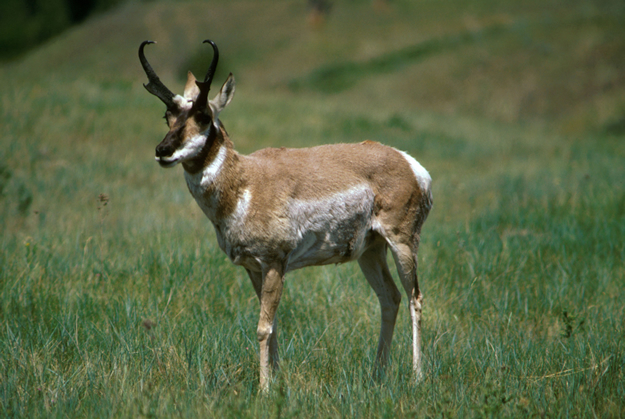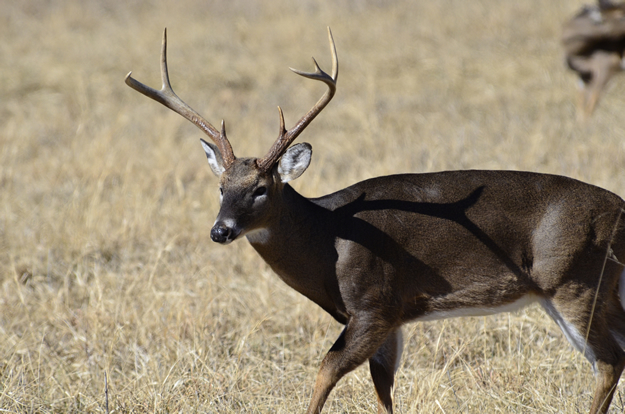
Editor’s Note: D.J. Randolph of Velva, North Dakota, is the Mossy Oak regional manager for North Dakota, South Dakota, Montana, Wyoming, Nebraska and Alaska. A Mossy Oak Pro Staff hunter since 2008 and a Pro Staff Manager for the last 3 years, he’ll begin to hunt antelope on Labor Day weekend.
 The West homes a wide variety of terrain and habitat. When I'm hunting in open terrain like the Badlands, I prefer to wear Mossy Oak Brush. If I'm hunting higher elevations with a number of pine trees, I like Mossy Oak Treestand. I think the new Mossy Oak Break-Up Country pattern will be good in many different terrains, besides the open brush country and the high pine forests.
The West homes a wide variety of terrain and habitat. When I'm hunting in open terrain like the Badlands, I prefer to wear Mossy Oak Brush. If I'm hunting higher elevations with a number of pine trees, I like Mossy Oak Treestand. I think the new Mossy Oak Break-Up Country pattern will be good in many different terrains, besides the open brush country and the high pine forests.
One thing I like about living in Wyoming is we can hunt almost all year long for something. I usually start off my hunting season with antelope in Wyoming on Labor Day in September. Wyoming has a huge population of antelope, the cost of tags for antelope is fairly reasonable, and I've got some friends who will allow me to hunt on some very-good antelope range in Wyoming. At one time, I hunted North Dakota quite a bit, but my home state has had a very severe winter for several years ago that killed a lot of our antelope. The antelope there are still trying to recover, and there's a very-limited season for our antelope in North Dakota right now. You can buy tags over the counter for some of the units in Wyoming, but other hunting units you have to draw for an antelope tag.
My favorite unit to hunt in Wyoming is Wildlife Unit 23, a draw unit where seldom are all the tags gone, because the unit is primarily made up of private lands. It also has the reputation of being difficult to find private land there where the landowner will let you hunt, so not very many people put in to draw for this unit. One of the members of Mossy Oak’s Pro Staff guides in this unit and told me, “I can get you and a friend on some property down here. Many of these properties in Unit 23 are hunted by outdoor TV producers who try to take an antelope on opening weekend. Then once that happens, these TV personalities can move on and attempt to take mule deer or elk. So, if you'll come to Wyoming in September, there's not a lot of competition from other people to hunt this unit.” This is why I wait until September to really start hunting there on a giant ranch that’s tens of thousands of acres.
 I'm often asked, “What is the real secret for taking a trophy antelope?” To do this, you must find a place to take a trophy antelope and be able to accurately judge the size of the antelope and his horns from long distances. When you're hunting in an open prairie without many landmarks or a range finder, judging distance can be a real nightmare. Also, if you haven’t hunted antelope for some time, because of the distance, judging the size of the antelope’s horns may be very difficult. To take a trophy antelope, I suggest spending a lot of time watching videos of people hunting and taking antelope, read plenty of articles on hunting antelope and learn what trophy antelope horns look like. One of the most misleading factors on scoring antelope horns is the height of the horns. For a trophy antelope, a better part of the horns to learn to judge is the thickness of the bases of the horns, and how long and sharp the diggers are. (Diggers are the protrusions that come straight off the horns.) These two parts of the horns drastically increase the score of the antelope’s antlers.
I'm often asked, “What is the real secret for taking a trophy antelope?” To do this, you must find a place to take a trophy antelope and be able to accurately judge the size of the antelope and his horns from long distances. When you're hunting in an open prairie without many landmarks or a range finder, judging distance can be a real nightmare. Also, if you haven’t hunted antelope for some time, because of the distance, judging the size of the antelope’s horns may be very difficult. To take a trophy antelope, I suggest spending a lot of time watching videos of people hunting and taking antelope, read plenty of articles on hunting antelope and learn what trophy antelope horns look like. One of the most misleading factors on scoring antelope horns is the height of the horns. For a trophy antelope, a better part of the horns to learn to judge is the thickness of the bases of the horns, and how long and sharp the diggers are. (Diggers are the protrusions that come straight off the horns.) These two parts of the horns drastically increase the score of the antelope’s antlers.
If you don’t live and hunt open ranges, I believe a range finder is almost absolutely essential. Generally an antelope will be a much-smaller animal than a deer. Therefore, if you're accustomed to judging the distance you are from a deer, the antelope will look much farther away than he is. Also, the antelope is a wily critter and has great eyesight. So, sneaking up on them to within bow range is often difficult.
 In a dry year, we’ll set-up blinds over waterholes we know antelope are frequenting. If you're going to spot-and-stalk antelope with a bow, you really need to find antelope on the plains that have dips in the terrain that will allow you to sneak in close enough to the antelope to get the shot with your bow. For that type of spot-and-stalk to be successful, two items are essential. You have to wear really good camo like Mossy Oak Brush, and you have to be able to move slowly as you approach the animal. Antelope have incredible eyesight. If an antelope sees the smallest amount of movement, he’ll spook and may run for 1/4-mile to 1-1/2-miles before he stops.
In a dry year, we’ll set-up blinds over waterholes we know antelope are frequenting. If you're going to spot-and-stalk antelope with a bow, you really need to find antelope on the plains that have dips in the terrain that will allow you to sneak in close enough to the antelope to get the shot with your bow. For that type of spot-and-stalk to be successful, two items are essential. You have to wear really good camo like Mossy Oak Brush, and you have to be able to move slowly as you approach the animal. Antelope have incredible eyesight. If an antelope sees the smallest amount of movement, he’ll spook and may run for 1/4-mile to 1-1/2-miles before he stops.
Also, we use decoys to slip up on antelope, but decoys are tricky. You may locate one buck that is very aggressive and comes to the decoy. Another dominant buck may want to gather up his does and get away from the decoys. So, one critical key to success is knowing what mood the antelope is in when you're hunting him. But if there’s one key secret to hunting antelope, the successful hunter has to be persistent.
I shot the first antelope I ever took in North Dakota at 24 yards. I’d hunted this buck for several days, and he had three does with him. Luckily, this field had a little bit of a roll to it. I crawled on my belly from hale bale to hay bale to get close enough to make the shot. I found I consistently could get to within 80 yards of antelope, but getting any closer was really difficult. When I finally got up to a bale of hay and saw the antelope, I was 2-1/2-hours into this stalk-and-crawl. I used my range finder and found the antelope were at 24 yards. I ducked back behind the hay bale and decided to range the antelope again, because I couldn’t believe I had gotten within 24 yards of this buck. That antelope were feeding on alfalfa, and I was behind a bale of alfalfa and drew my bow. Then, I very slowly leaned out to the side of the bale. All I had to do was remain calm and release the arrow. When the buck took the arrow, he started running. I saw the buck go down about 1/4-mile away from where I had shot him. But instead of going after my buck, I went back to my pickup truck where my hunting buddy had been watching the antelope and me with binoculars. He had identified a good landmark where he saw the antelope fall. So, we ate lunch and waited for about an hour. Then together we walked out to where the buck had fallen and dragged him back to the truck.
I just got this antelope back from the taxidermist, filled out all my paperwork and sent it in to Pope and Young (P&Y), because this buck scored 69 -3/4 inches, even after the deductions. This was my first Pope and Young antelope.
For information on making jerky from your antelope and other big game animals to provide a protein-rich snack, you can download a free book from http://johninthewild.com/free-books.
Tomorrow: Baling Up North Dakota’s Big Whitetail Bucks



























